Can an Electric Car Really Replace Central Park's Horse-Drawn Carriages?
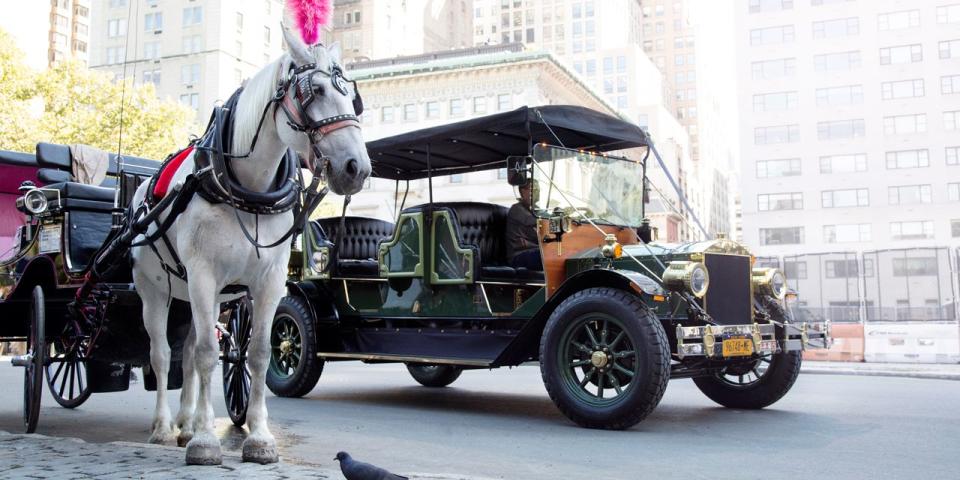
From the December 2014 issue of Car and Driver
“We are as famous as the gondolas in Venice. That’s how iconic we are in this city.” So says Ian McKeever with his Irish brogue and the hyperbole that apparently affects all the horse-drawn-carriage drivers in New York City’s Central Park. “I’d say that 90 percent of the horses you see here, if they weren’t here, they’d be dead.”
Thing is, New York’s mayor, Bill de Blasio, wants them gone. And the animal-rights activists who helped elect him last year have already produced an alternative: a 6400-pound electric dreadnought styled to resemble brass-era motor carriages. Called the Horseless eCarriage, it’s intended to keep all the 160-or-so current carriage drivers—every one a card-carrying Teamster—employed, while the 220-or-so geldings and mares currently in the tourist business are retired to glistening glades where they’ll find gentle contentment among self-actualized unicorns and technicolored rainbows. Or, conversely, if you believe the drivers, shipped to a rendering plant.
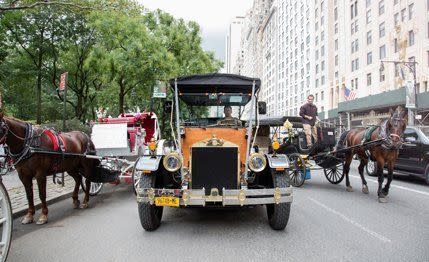
Cars won the war against horses more than 100 years ago, but here’s one lingering battle. It was a natural for a comparison test, though it would have to be conducted in the middle of traffic in one of the busiest cities on earth. Except that the private Central Park Conservancy that manages the place generally despises all automobiles and doesn’t want the eCarriage in the park, much less a car magazine testing one. And the leaders of the pro-horse Historic Horse-Drawn Carriages of Central Park NYC wanted nothing to do with us, either. Undeterred by the challenges and unwounded by those slights, we did it anyhow.
Exploring the governance of New York City is unpleasant. But to tell this story, we must. Gotham politics are an intramural blood sport. Virtually everyone involved is a Democrat, the rhetoric is over the top, the newspapers blast lurid headlines, celebrities stir the pot on both sides, and real estate is often lurking at the core of every issue. All New Yorkers have an opinion, though only 24 percent of eligible voters turned out for the last mayoral election.
New Yorkers for Clean, Livable and Safe Streets (NYCLASS) is the animal-rights group behind the eCarriage. Founded in 2008 by Steve Nislick, a 70-ish parking-garage mogul who lives near Central Park, the group has relentlessly portrayed the horse-drawn-carriage owners and drivers as cruel and abusive to the animals. It’s also been politically savvy in backing de Blasio. According to the New York Daily News, Nislick contributed $174,000 for the 2013 Democratic primary, including money for attack ads against putative front-runner Christine Quinn that many believe opened the door for de Blasio’s nomination. The mayor owes him and his horse-hugging cohorts.

Considering Nislick’s real-estate acumen, the carriage drivers read into the NYCLASS campaign not an effort to save equines, but a cynically veiled attempt to make a deal for the ridiculously valuable land under the stables in which their horses are housed. “I’ve never been interested in these properties and do not want them now,” Nislick wrote on the NYCLASS website in January, further promising to not bid on any of the four stables, all located in the rapidly gentrifying west-side neighborhood of Hell’s Kitchen, should they come up for sale.
While de Blasio has promised to get rid of the horse-drawn carriages, no such legislation has yet made it to the contentious 51-member city council. And the issue seems to be slipping down the mayor’s list of political priorities. NYCLASS, though, had the eCarriage prototype ready for us to drive.
Jason Wenig of the The Creative Workshop, a car restoration and fabrication shop in Dania Beach, Florida, is a smart carbuilder. Contracted by NYCLASS to design and build the first eCarriage, Wenig stuck with proven components and came up with a design that hits a sweet spot between Disneyland and downtown 1907.
Under the faux olde-tyme bodywork sits a straightforward steel ladder frame with solid axles on leaf springs spanning a 158-inch wheelbase. Between the frame rails are 72 lithium-ion battery cells sending amperage forward to an 84-hp AC motor. The 184 pound-feet of torque is then routed through a reduction gearset to a Dana 60 rear axle.
It’s a big hoss. The eCarriage’s wheelbase is 28 inches longer than a 2015 Suburban’s. The eCarriage is taller, too, rising just over seven feet to the top of its flat windshield, almost a full foot taller than a Sub. Small and delicate this three-ton horse liberator is not.
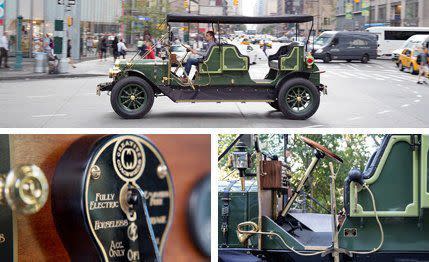
“I called almost everywhere looking for batteries,” says Wenig, with a tinge of Brooklyn in his voice. “Flux, Calib Power, A123 . . . none of them were eager to work with me. So I wound up with these batteries from Sinopoly in China.” The array charges through a standard SAE J1772 connector in about six hours. Fully charged, says Wenig, it’s good for 100 miles—maybe longer when restricted to a maximum 5 mph within Central Park.
Along Fifth Avenue, we saw a top speed of 24 mph, which took the eCarriage more than 15 seconds to reach. The acceleration itself is easygoing despite a wailing whine from the reduction gears (something to be engineered out if it goes into production). Wenig and his staff of 10 built the brass-era body from aluminum and wood, and the craftsmanship is impressive. The paint is perfect and the details are beautifully rendered down to the custom grab handles. It’s only up close that one notices that the brake drums are painted covers over more-modern discs and the ancient-looking oil headlamps actually contain LED elements.
Hauling one’s self up can challenge anyone’s dignity, but the three rows of bench seats covered in button-tufted vinyl are comfortable and it’s easy to stretch out in back. The thick-rimmed wood steering wheel sits on a towering column that feeds straight down to an unassisted 16:1 recirculating-ball steering gear.
Combine the primitive column with replica BFGoodrich Silvertown bias-ply truck tires mounted on 6.0x24-inch Forgeline aluminum wheels and the result is hazy steering. The effort isn’t high, but the reactions are slow. That’s fine at low speeds and with no traffic, but unnerving when a squadron of Camry cabs squeezes the doorless eCarriage against a double-decker tourist bus.
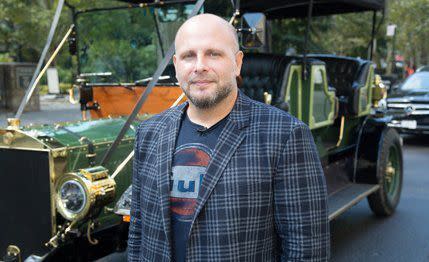
The eCarriage doesn’t enjoy the deference from other traffic that its horse-drawn competition does. Especially when making the U-turn the horses regularly execute in the middle of 59th Street to get back to Central Park’s entrance. But driving through the city, crowds enthusiastically flocked to the eCarriage. Wenig’s design is a knockout right now, at the height of its novelty. But can it sustain that if it becomes a part of the city’s background noise?
What the eCarriage lacks is history. If there were ever a time when motorized carriages chugged through Central Park at the turn of the 20th century, it was a flickering moment. Meanwhile, horses have cruised its greenscaped byways for more than 150 years.
The ultimate obstacle for the eCarriage, though, may be economic. Even if the vehicle price drops to $150,000 each, as NYCLASS hopes (the prototype cost nearly three times as much), that’s substantially more than a $2500 horse plus a brand-new $7500 carriage from the Troyer Carriage Company of Shipshewana, Indiana. Even factoring in $1300 a month to care for each horse, the eCarriage numbers are tough to crunch.
New York City awards only 68 taxi-like medallions authorizing operation of a horse and carriage within Central Park. And if you believe what the carriage drivers say, every horse and every carriage has been on Sex and the City and/or Law & Order several times.
The carriages that line up along 59th Street waiting for tourists to take a 20-minute loop through the park for $50 aren’t pristine contraptions. The best of them are a bit faded, most are threadbare, and a few are just plain ragged. The horses that pull them are ordinary draft animals—usually mixed-breed geldings or mares that are about 16 hands (5.3 feet) tall at the shoulder—with supernaturally calm temperaments. The drivers are a grab bag of immigrants with a few native New Yorkers mixed in. Their industriousness, fashion sense, and hygiene, both human and equine, vary greatly.
We took the deluxe 40-minute tour for $90 with Turguy Gunn, a Turk with four years of driving experience. Hudson, an 11-year-old gelding, was pulling. “He just came back from vacation,” Gunn explains about Hudson. “He’s been in the pasture for like three months like the law says. He’s going to be ready for Christmastime.” The law actually requires an annual five-week pasture stay for each horse.
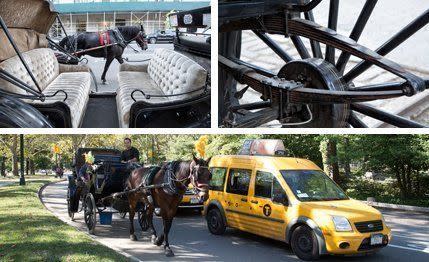
At more than 22 feet long from the tip of Hudson’s nose to the back of the carriage, the combination isn’t small. But the carriage’s front axle pivots so the turning radius is compact. The horse’s biggest advantage is subtler than that, however: A horse-drawn carriage is effectively a semi-autonomous vehicle.
As we quietly clopped through the park, Gunn turned around in his seat to explain exactly which building along the park’s perimeter had been featured in Ghostbusters. He effectively left the driving up to Hudson. The horse knows the route, is smart enough to sustain the 4-mph pace, and will rarely do anything that puts the carriage in danger.
Having two brains at the controls allows the driver to interact with his customers, face to face; that’s impossible with the eCarriage. A horse just makes it a better tourist experience, even if you’re staring at the back end of it.
Horses aren’t the brightest animals, but they’re smart and reliable enough to be depended upon. Of course, the horses are at risk in city traffic, but so is everybody. In the past few months, two humans have been killed in the busy park by collisions with speeding bicyclists. Absolute safety is guaranteed to no animal.
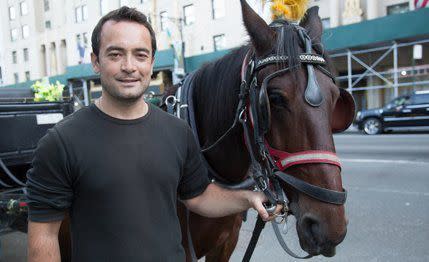
“As long as people feel the horses are well taken care of, there should be no problem,” explains McKeever, who owns Hudson and the carriage he was pulling. “People can’t romanticize a machine. I can’t see any rationale for anyone to want one of those jalopies.” Romanticize a machine? Us?
Between 2007 and 2012, the equine population in this country dropped by 10 percent, according to the U.S. Department of Agriculture. When horses don’t have jobs they become expensive luxuries, especially in a recession, and fewer people are willing to pay that price. The Central Park horse-drawn carriages are one of the few chances left for people to connect with working horses and their ancestors that helped build New York City.
In the long run, though, NYCLASS will likely win this battle. If not because it’s able to get the horses banned, but because the land under the horses’ stables is so valuable that the stable owners won’t be able to resist selling.
And once the horses are gone, they won’t be coming back.
VehicleHorse-Drawn CarriageHorseless eCarriageBase Price$10,000*$150,000*DimensionsLength268 inches220 inchesWidth73 inches88 inchesHeight21.5 hands86 inchesWheelbase100 inches158 inchesFront Track57 inches76 inchesRear Track62 inches75 inches
PowertrainPropulsionHudson, 11-year-old geldingpermanent-magnet synchronous AC motorPower1 hp84 hpEnergygrain and oats46-kWh lithium-ion batteryLb per HP1700.076.2DrivelineTransmissioncollar and hames harness1-speed direct driveDriven Appendages/Wheelsallrear
ChassisSuspensionF: rigid axle, leaf springs
R: rigid axle, leaf springsF: rigid axle, leaf springs
R: rigid axle, leaf springsBrakesF: steel horseshoes
R: 10.5-inch drumF: 12.5-inch vented disc
R: 13.0-inch vented discTiresF: 41x2, solid rubber
R: 53x2, solid rubberBFGoodrich Silvertown 38x7, bias plyC/D Test ResultsAcceleration0–3 MPH2.0 sec3.2 sec0–20 MPH–13.5 secTop Speed4 mph (gait ltd)24 mph (redline ltd)WeightCurb1700 pounds6400 pounds*C/D estimate.
tested in New York, New York, by Eric Tingwall
Final ResultsVehicle
Rank
Max Pts. Available
1
Horse-Drawn Carriage
2
Horseless eCarriageComfort555Fit and Finish10510Interior Styling1079Exterior Styling10910As-Tested Price20201Subtotal554635
PowertrainAcceleration202014Subtotal202014
ChassisAuthenticity10107Driver Interaction10102Ride Quality10107Fun to Ride252120Subtotal555136
Grand Total13011785
You Might Also Like

 Yahoo Autos
Yahoo Autos 